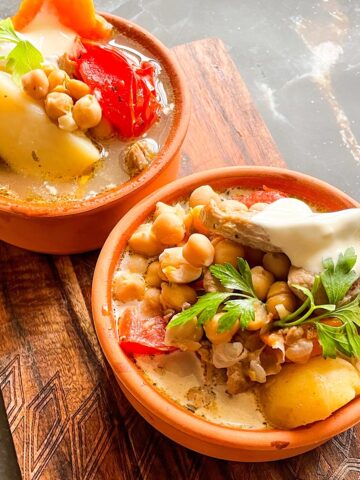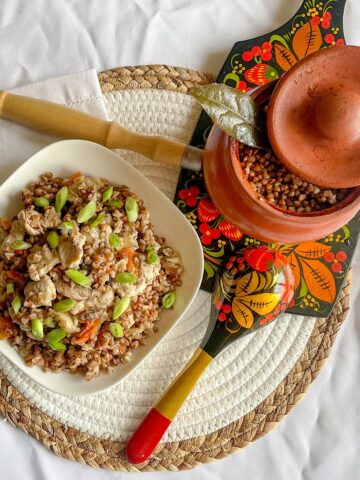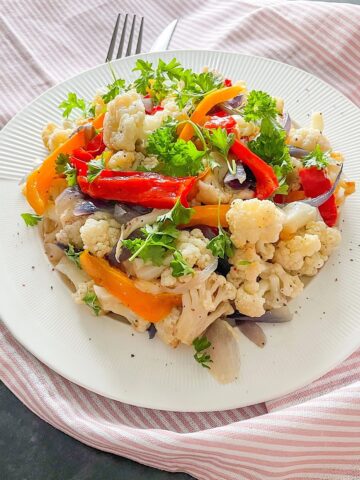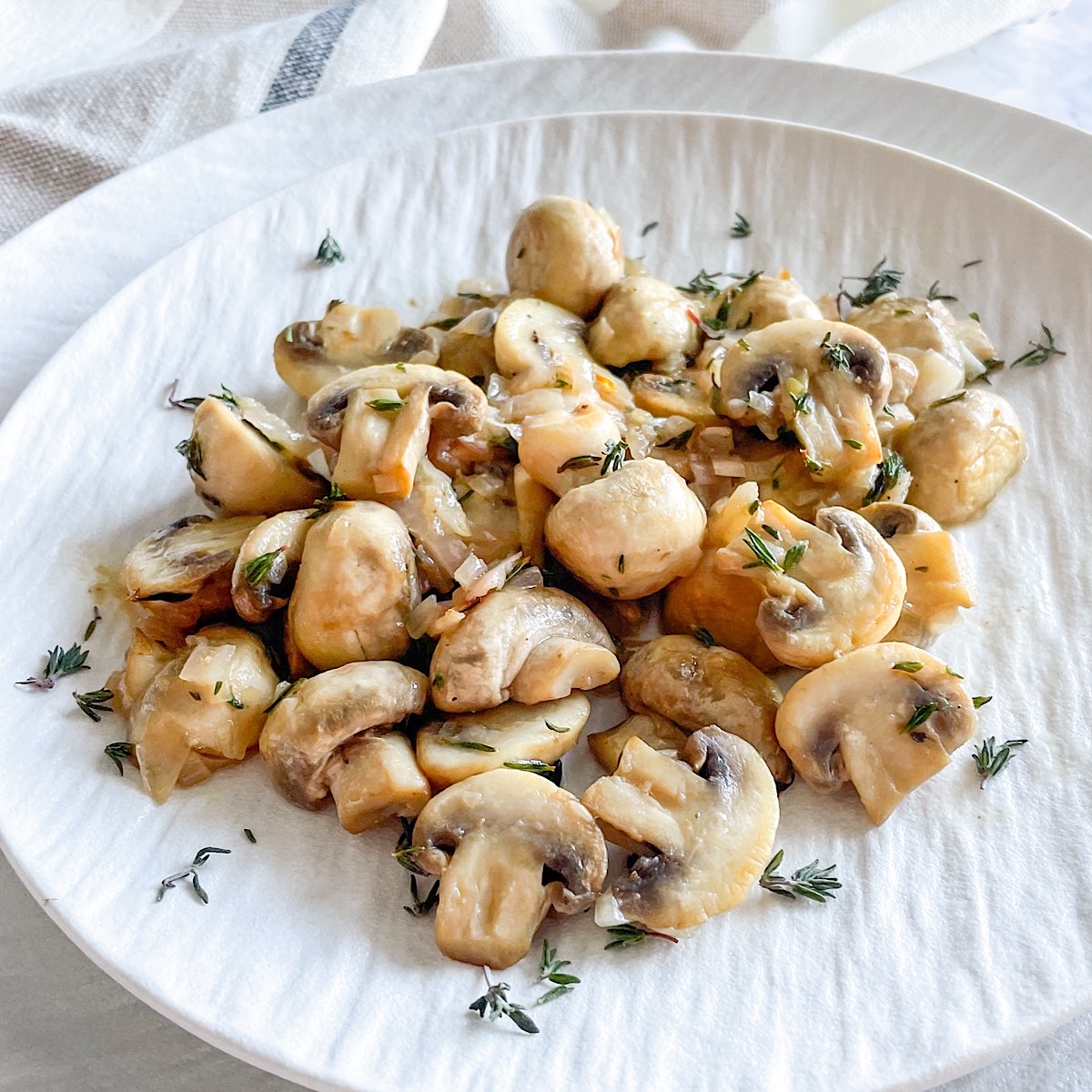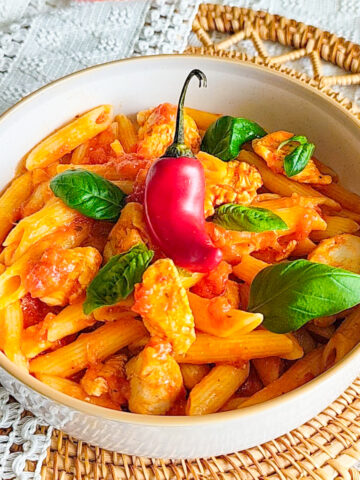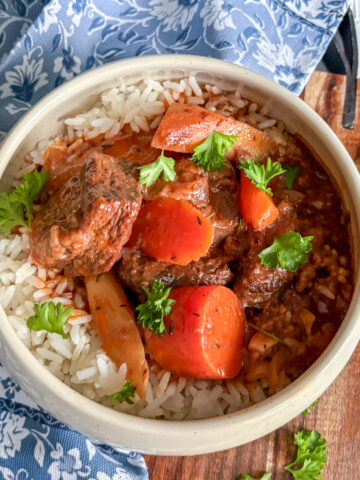Beef Plov is a flavour-packed, spice-rich rice and meat dish perfect for cosy dinners or family celebrations table. Tender beef, vibrant spices, and fluffy rice come together in this classic Uzbek-style beef pilaf that never disappoints.

When I first made Beef Plov, I realised it could easily become a signature dish at any dinner table. It’s warm, comforting, and deeply aromatic. Whether you’re a plov enthusiast or making it for the first time, this recipe will walk you through each step, making sure you get that perfect balance of flavour and texture. Beef Plov has depth, heat, and soul – and it’s easier to make than you think.
Jump to:
What Is Plov?
Beef Plov isn’t just a recipe — it’s part of a centuries-old culinary tradition rooted in Central Asia and widely celebrated across Eastern Europe, the Caucasus, the Middle East, and beyond. Known as osh, pilaf, pilau, or palov, this rice-based dish is especially central to Uzbek culture, where it’s both everyday nourishment and a symbol of hospitality and celebration. In fact, UNESCO has recognised Uzbek plov as part of the world’s intangible cultural heritage — a testament to its deep cultural significance.
Plov is prepared in nearly every household across Uzbekistan and is equally beloved in countries like Tajikistan, Kazakhstan, Kyrgyzstan, Azerbaijan. From home kitchens to school canteens, and festive gatherings, plov - Плов is a beloved and familiar dish throughout Russia. It's a staple in both everyday meals and special occasions, appreciated for its warmth, heartiness, and rich flavour. This is thanks not only to its roots in Central Asia but also to the cultural blending and shared culinary traditions across the post-Soviet space.
There are many variations of plov, each with its own story. Tashkent plov is a benchmark, often cooked in a kazan (a large cast-iron cauldron) over an open flame. You’ll find “wedding plov” (той палов) cooked with lamb, raisins, and even dried apricots for a slightly sweet note — a version reserved for life’s most joyful occasions. Some versions use yellow carrots, others include chickpeas or quail eggs. In cities like Samarkand, plov is layered and steamed gently; in Bukhara, everything is cooked together.
No matter the variety, all plov begins with zirvak — a rich base of meat, onion, and carrot simmered in oil with spices. It’s this slow-cooked foundation that transforms simple rice into something deeply aromatic and complex.
In this recipe, I’m sharing a version of Beef Plov, made in the spirit of traditional Uzbek cooking, but adapted slightly for the modern home kitchen — no open fire or kazan required. It honours the original structure and flavours while making the process more accessible for everyday cooks.
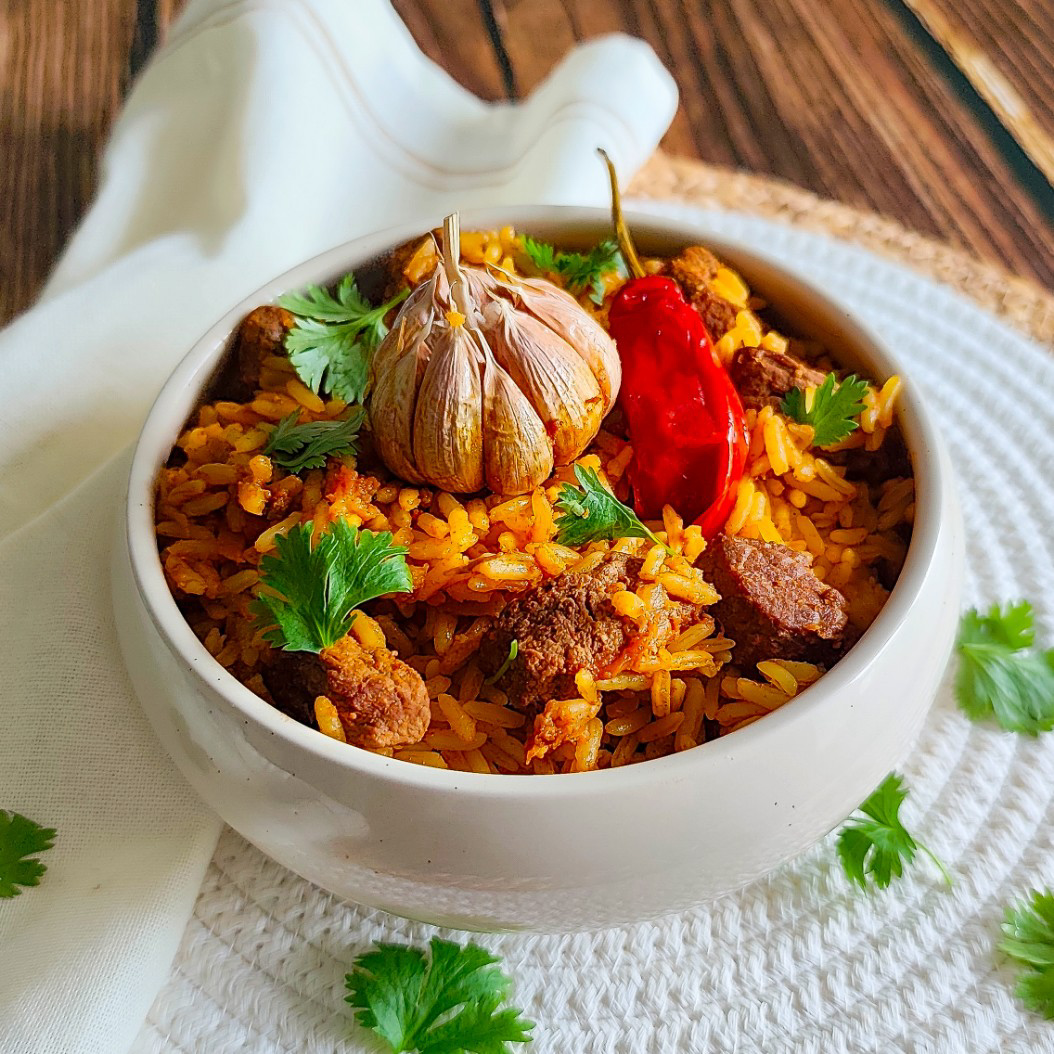
Ingredients for Beef Plov
Here’s what I use for this dish and why it works. I’ve kept it close to traditional Uzbek plov, where every ingredient has a clear role — nothing extra, nothing missing. From the fatty beef and sweet carrots to the essential cumin and garlic, it’s all about building bold, honest flavour.
- Beef (with some fat) – Adds richness and flavour. Slightly fatty cuts like stewing beef are perfect.
- Carrots (cut in thin strips) – Naturally sweet and vibrant. In traditional plov, yellow carrots are used, but standard orange ones work beautifully too.
- Onions – A key component, they create a rich, sweet base.
- Parboiled rice – Keeps its structure and doesn’t turn mushy. Devzira (Devsira) rice is ideal if you can find it. Basmati and Jasmin rice would be great as well, but I just like the easy-peasy parboiled rice because I do not need to rinse it.
- Turmeric – Gives the rice its golden glow and earthy aroma.
- Paprika – Brings a sweet warmth and a lovely reddish hue.
- Cumin (Zira) – The heart of authentic plov flavour. Don’t skip it.
- Butter – Adds lusciousness and silkiness to the dish. Look, the Plov is not about the "low-fat". It should be fat. Fat = Taste. And in the case of Plov, it has to be fatty and rich in taste dish, and in authentic recipes they start plov by melting lamb lard - kurdyuk. And if you want to experience true tastes - so check the Middle Eastern butchers.
- Tomato paste – Boosts umami and rounds out the spices.
- Salt and Pepper – Essential for seasoning in stages.
- Whole Garlic Head & Red Chilli – Traditional toppings that infuse gentle spice and aroma during the final steam.
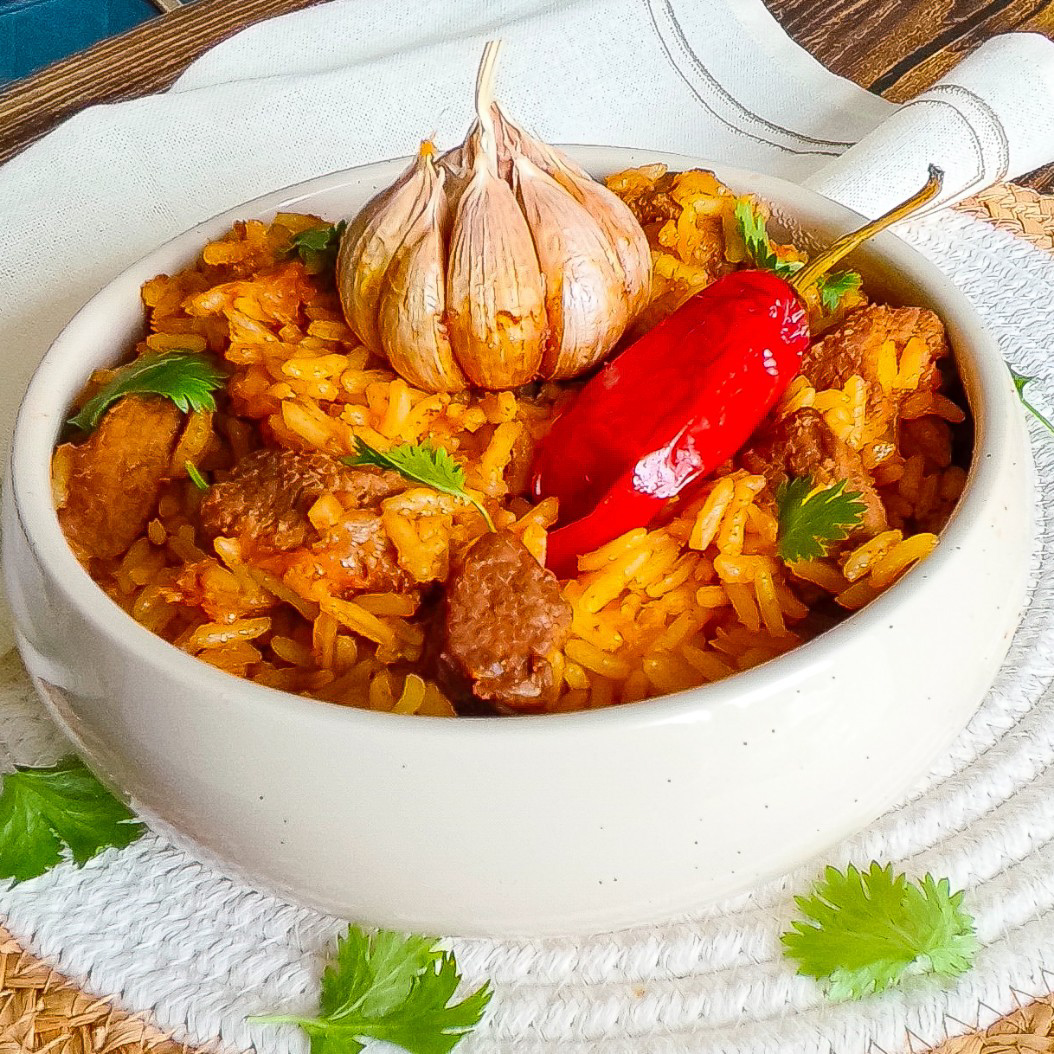
Instructions
I know Beef Plov can look a bit intimidating at first, but trust me — it’s much simpler than it seems. Once you understand the flow, it’s just about layering things in the right order and letting the flavours do their thing. But remember not to stir the rice until it is fully cooked. I am usually cooking in multicooker. Traditional plov is cooked in kazan - large cast-iron pot, I have one, but I am too lazy to take it out! Any heavy based dutch oven or cast-iron pot would suit.
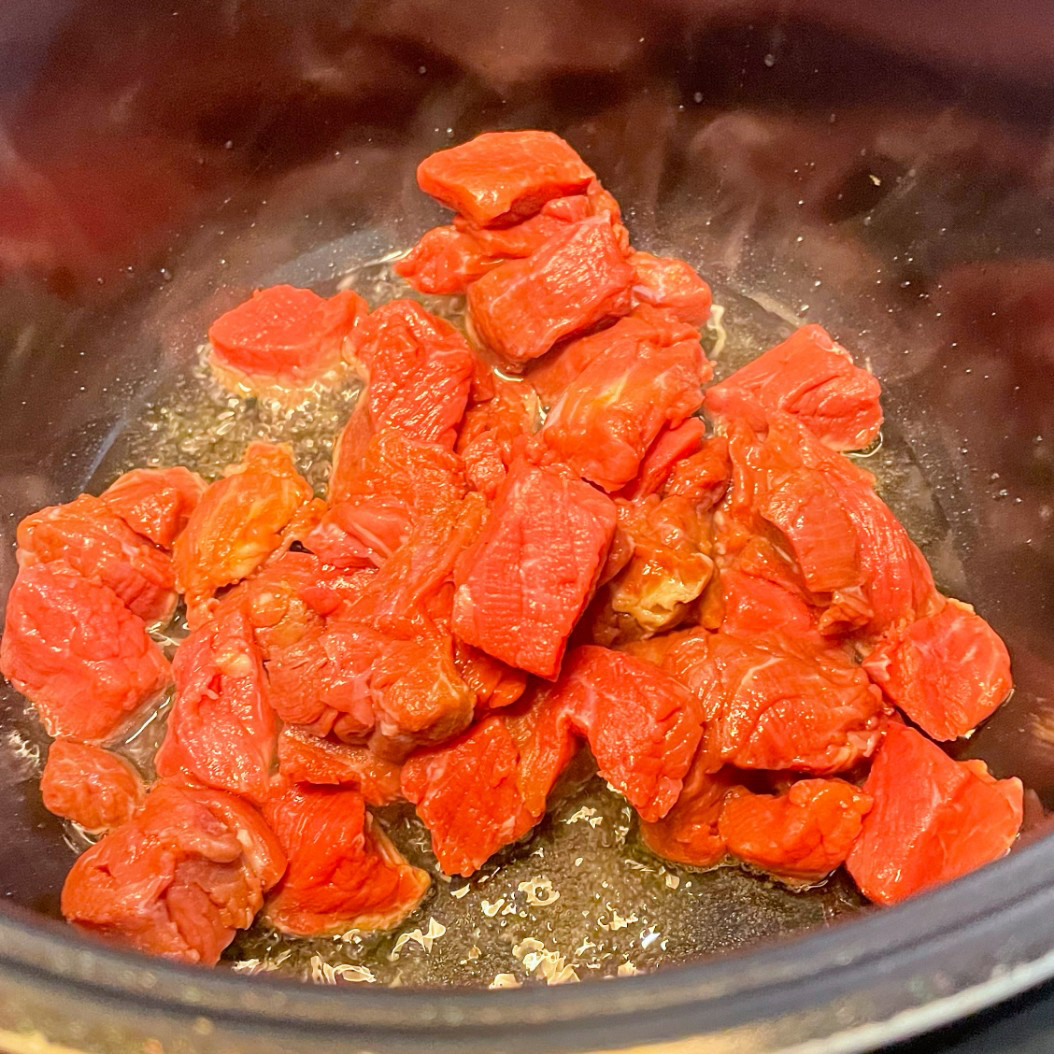
- Step 1: Start by preparing all the ingredients. Rinse the beef, pat it dry, and cut it into medium cubes. Peel and slice the onions into thin half-rings. Wash and peel the carrots, then slice them into matchsticks — not too thin. Heat oil in a heavy-based pot or Dutch oven (a multicooker works too). Add the cubed beef and fry it over medium-high heat, stirring occasionally, until it’s deeply browned on all sides. Once golden, transfer the beef to a plate and set it aside.
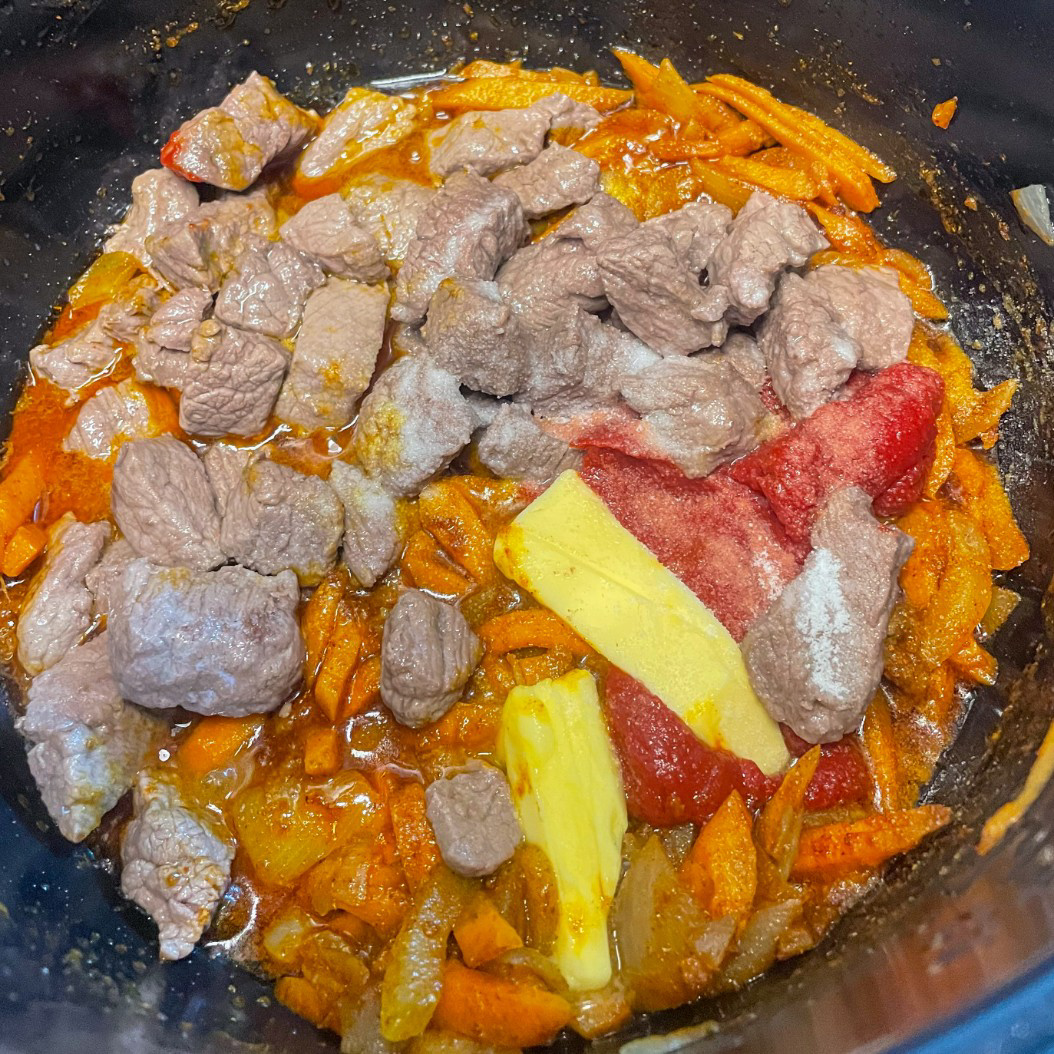
- Step 2: In the same pot, add the sliced onions. Fry for about 3 minutes, stirring gently. Add the carrots, mix everything, and let it cook on low heat for 10 minutes. Return the seared beef to the pot. Season with half of the spices, a good pinch of salt, and black pepper. Stir in the butter and tomato paste. Pour in boiling water so it covers the meat and vegetables by about 1.5 to 2 cm. Bring to a gentle boil, and simmer for at least 40 minutes until the beef becomes tender and the base — the zirvak — is rich and fragrant.
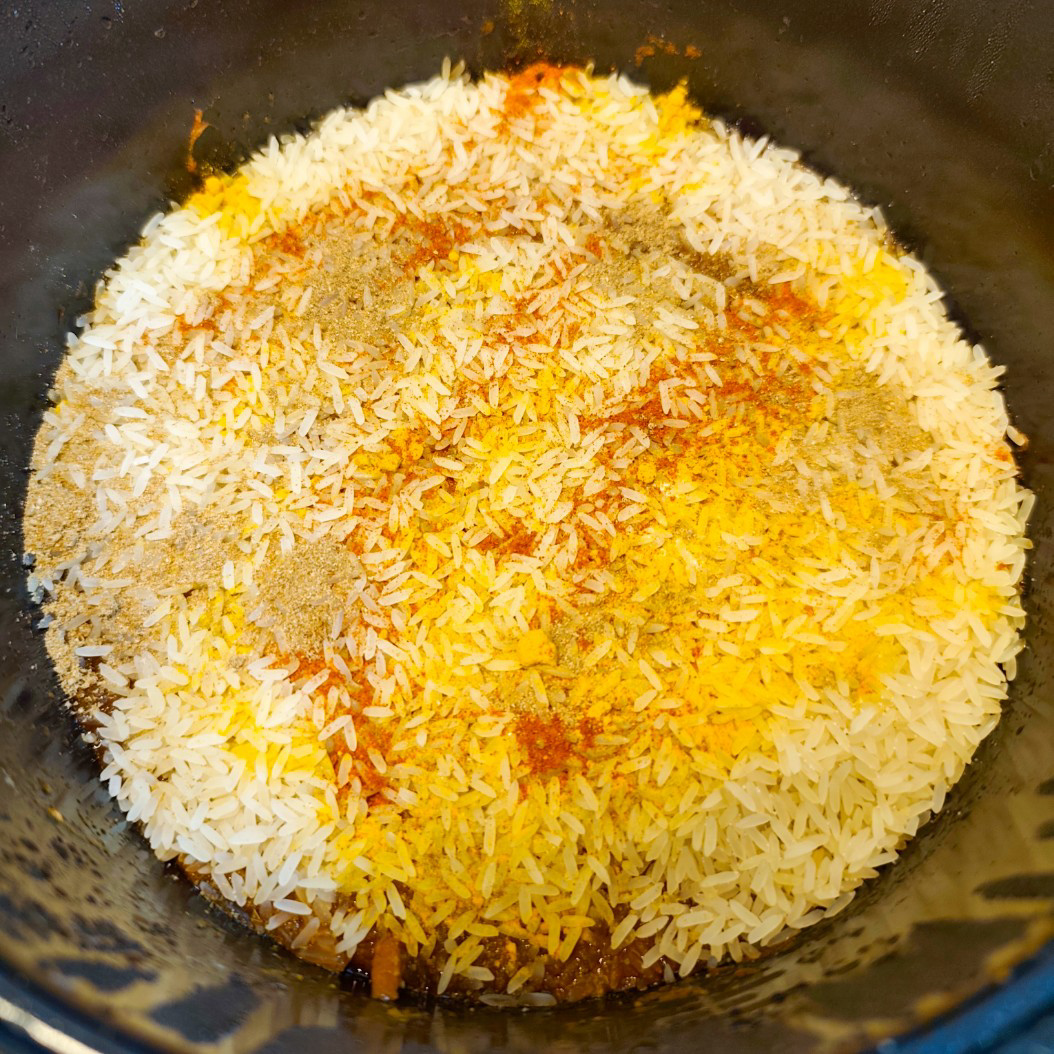
- Step 3: Once the zirvak is ready, spread the rice evenly over the top — do not stir. Sprinkle over the remaining half of the spices, plus some more salt and pepper. Use the end of a wooden spoon to poke several holes down through the rice to help the steam escape evenly. Slowly pour in more boiling water using a skimmer or ladle, just enough to cover the rice by 2 cm. Cook over medium heat for about 20 minutes, checking occasionally that the water hasn’t completely evaporated.
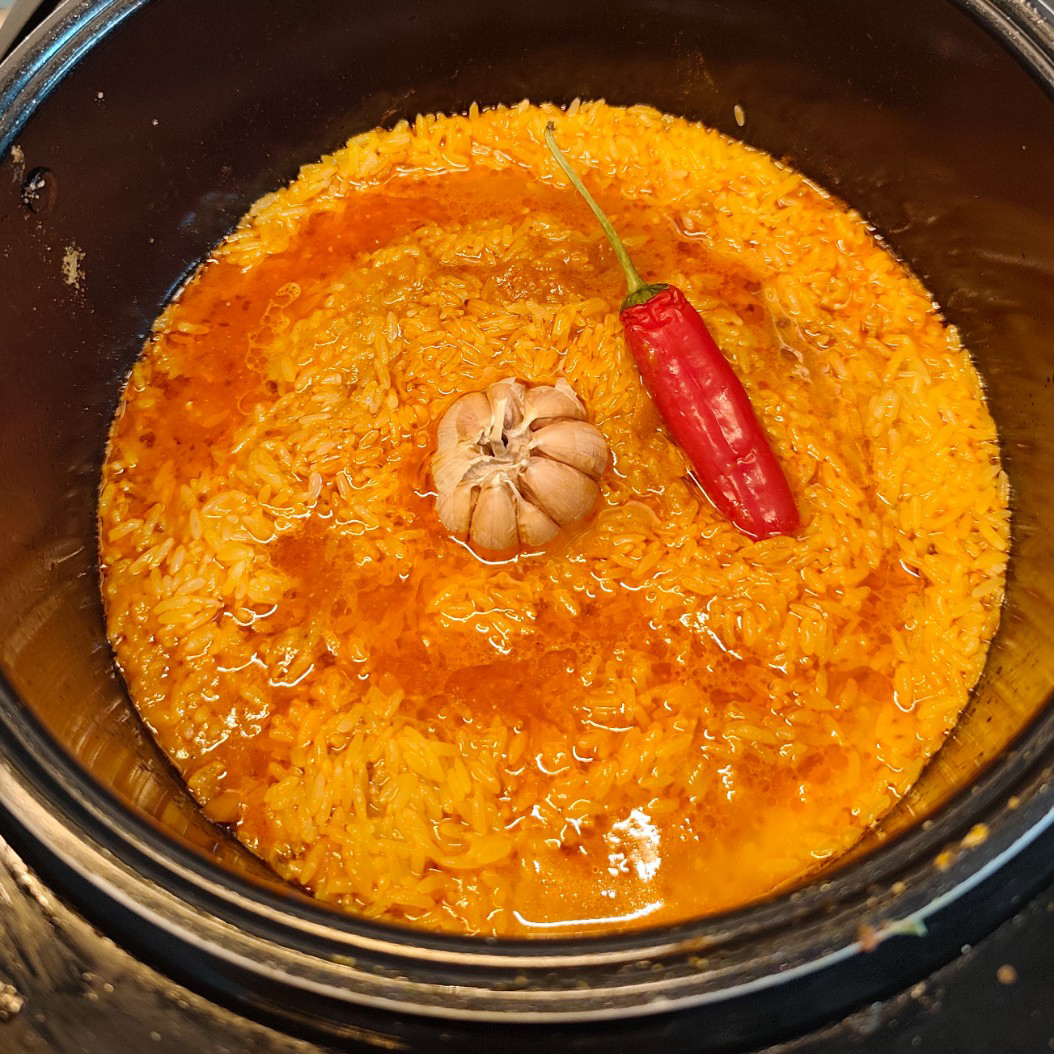
- Step 4: When the rice has absorbed roughly half the liquid, gently push the whole garlic head (with the outer skin peeled off) and red chilli pepper into the centre. Cover the pot with a lid and reduce the heat to low or minimum. Let it steam for another 20–30 minutes until the rice is fully cooked and fluffy. Keep an eye on it — you can add a bit more boiling water if the rice is still firm and too dry.
Tips:
- Never stir the plov once the rice has been added — this is key to the signature texture.
- Poking holes in the rice helps the steam escape, preventing overcooking at the top.
- Pouring water over a slotted spoon helps it distribute gently, so the rice stays in place and cooks evenly.
Serving and Storage
Traditionally, beef plov is served on a large communal plate and eaten with spoons. You can garnish with chopped fresh herbs like parsley or coriander. It pairs beautifully with fresh tomato and onion salad (achichuk), pickled vegetables, or plain yoghurt to cut through the richness.
To store:
Beef Plov also tastes even better the next day — the flavours deepen, and the rice stays beautifully fluffy when reheated.
Cool fully and refrigerate in an airtight container. Keeps well for up to 4 days. Reheat in the microwave or on the stove with a splash of water to revive the rice.
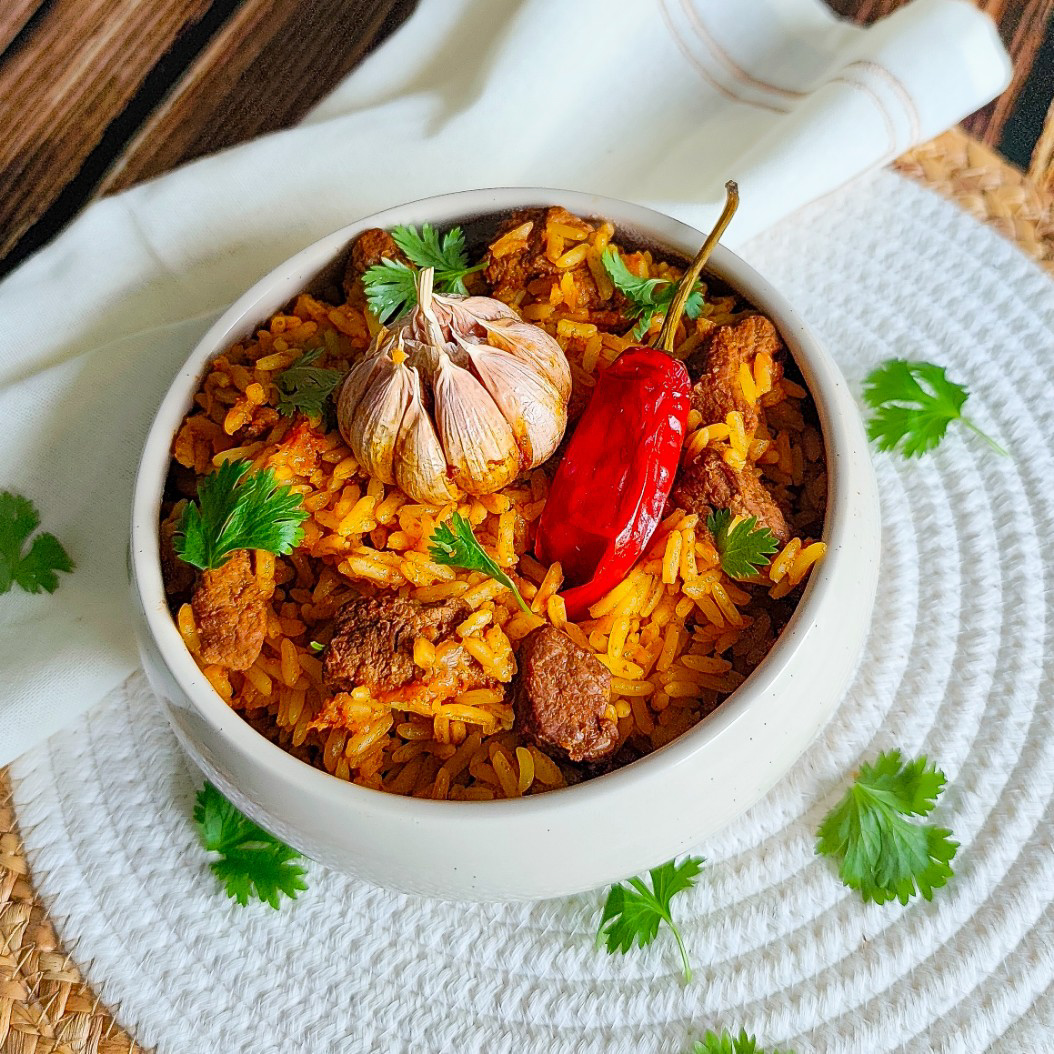
5 Cooking Tips & Notes for Beef Plov
- Use a heavy-bottomed pot – cast iron or Dutch oven is ideal.
- Don't stir the rice once added – plov must stay layered.
- Add boiling water only – cold water stops the cooking process.
- Let beef plov rest after cooking – it fluffs up better.
- Slice carrots into matchsticks – not grated, to keep texture.
FAQ
What is plov and where is it from?
Plov is a traditional rice dish with roots in Central Asia, particularly Uzbekistan, where it’s considered a cultural symbol. It's also widely popular across Russia, Kazakhstan, Tajikistan, Azerbaijan, Ukraine, and other parts of Eastern Europe and the Caucasus. The dish is known for its layered cooking technique, use of fragrant spices, and a base called zirvak — a slow-cooked mix of meat, onions, carrots, and seasonings.
What’s the difference between plov and pilaf?
Pilaf is a general term used in Western cooking, often for rice cooked with broth and spices. Plov is the traditional name used in Central Asia and Eastern Europe and follows a specific technique — no stirring after rice is added, steam cooking, and a rich meat-vegetable base. Plov typically has bolder spices, layered flavours, and more defined structure than Western-style pilafs.
How do I keep the rice from becoming mushy?
The biggest mistake is adding too much water. Always measure conservatively — it’s better to add more hot water as needed during cooking. Also, if you're using anything other than parboiled or Devzira rice, rinse it thoroughly in cold water until it runs clear. Parboiled rice is a great choice for beginners because it naturally stays fluffy and separate.
What is zirvak and why is it important?
Zirvak is the flavour base of plov, made by simmering meat, onions, carrots, and spices in oil or fat. It’s the step where most of the flavour is developed, and it's what sets plov apart from basic rice dishes. Once the zirvak is ready, the rice is added on top and steamed — never mixed — allowing the flavours to soak upward into every grain.
What are the traditional spices used in plov?
The most essential spice is zira (Central Asian cumin), which gives plov its distinctive aroma. Others include turmeric, paprika, and black pepper. Some regional variations also include saffron, dried barberries (barbaris), garlic, and even whole spices like coriander seeds or star anise, depending on local customs.
Do I need a kazan to make authentic plov?
A kazan is traditional and ideal, but you can make excellent Beef Plov at home using a Dutch oven or any heavy-based pot. The key is even heat distribution and a lid that seals well to trap steam during the final cooking stage.
Can I cook plov in a multicooker or Instant Pot?
Yes, and it works surprisingly well. Use the sauté mode to build the zirvak, then layer in the rice and switch to rice or pressure cook mode. Just be careful not to use too much water and let it rest with the lid closed after cooking to allow the rice to absorb residual moisture.
Related
Looking for other recipes like this? Try these:
Pairing
These are my favorite dishes to serve with Beef Plov:
Beef Plov Recipe
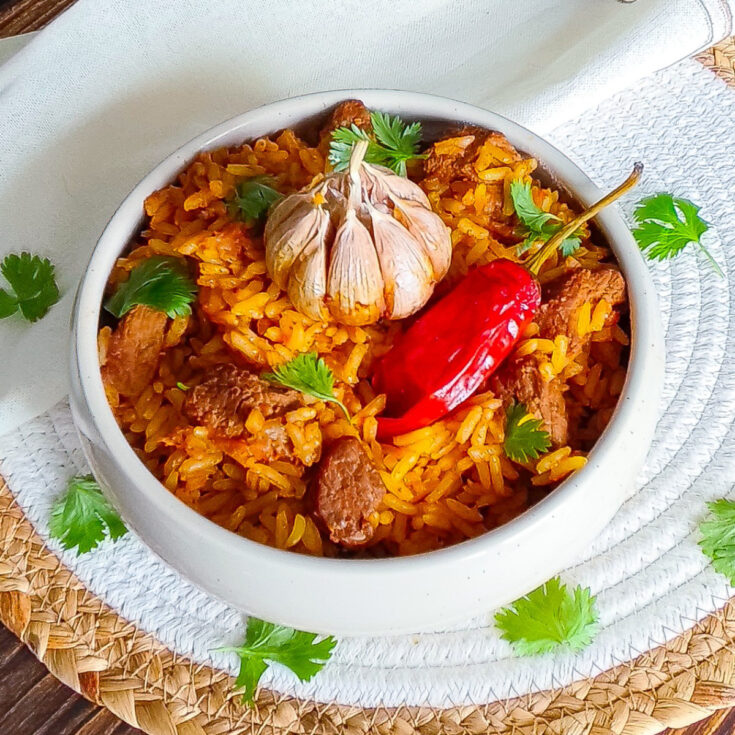
Ingredients
- 500g beef, cubed (preferably with some fat)
- 2 carrots, cut into thin matchsticks
- 2 onions, thinly sliced
- 300g parboiled rice (or Devzira rice if available)
- 1 tablespoon turmeric, divided
- 1 tablespoon paprika, divided
- 1 tablespoon cumin (zira), divided
- 50g unsalted butter
- 2 tablespoon tomato paste
- Salt and pepper to taste
- 1 head of garlic, whole and unpeeled
- 1 whole chilli pepper
- Boiling water
Instructions
- Wash and cube the beef. Heat oil in a heavy-bottomed pot. Brown the beef on all sides and remove it.
- Sauté sliced onions in the same pot until soft. Add carrots and cook for 10 minutes on low. Return the beef, season with half the turmeric, paprika, cumin, and some salt and pepper. Stir in butter and tomato paste. Pour in enough boiling water to cover everything by 2 cm. Simmer for 40 minutes.
- Evenly spread the rice on top of the meat mixture. Sprinkle with the remaining spices, salt, and pepper. Make steam holes through the rice using a spoon handle. Carefully pour in more boiling water to cover rice by 2 cm. Cook uncovered on medium for 20 minutes.
- Once water is mostly absorbed, push the garlic and chilli into the rice. Cover and cook on low for another 20–30 minutes until rice is tender. Turn off heat and let sit covered for 10–15 minutes before serving.


